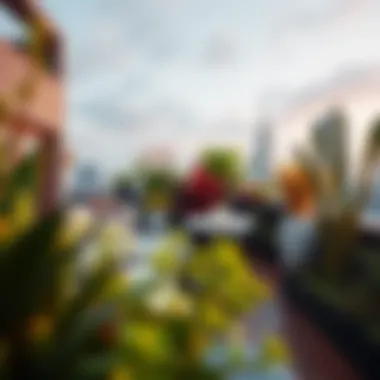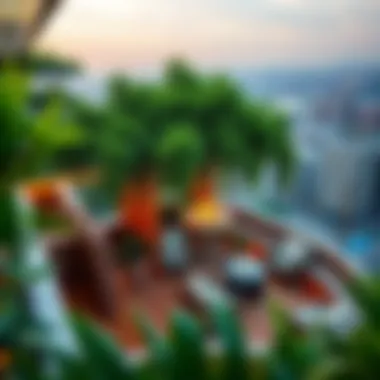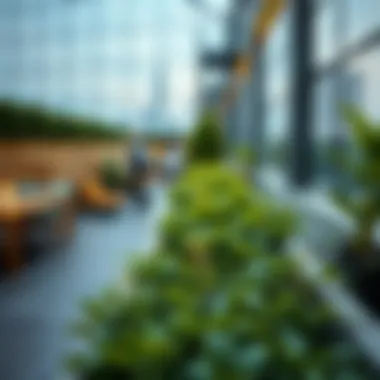The Sky Garden: Transforming Urban Living Spaces


Intro
Urbanization is reshaping the landscapes of cities around the world. As population densities soar and concrete jungles expand, there’s a pressing need to integrate nature into our daily lives. The Sky Garden concept arises as a novel solution, addressing the challenges of urban living by seamlessly blending architectural flair with lush greenery. This concept is not merely an aesthetic choice but rather a strategic response to the challenges of modern urban environments.
By harnessing the power of nature, Sky Gardens transform rooftops and balconies into verdant retreats that restore a sense of connection to the environment. The Sky Garden emerges as more than just an innovative design trend; it represents a transformative approach to how we experience urban life. The intertwining of horticulture and metropolitan infrastructure presents advantages that are multi-faceted, impacting well-being, community dynamics, and even property values.
In exploring the various dimensions of Sky Gardens, this article will delve into their multitude of functions, benefits for residents and the urban ecosystem, and their tremendous potential as sustainable building practices. With notable examples from Dubai and other global cities, the discussion will highlight not just the beauty of these green spaces but their real-world implications on urban living. Ultimately, The Sky Garden stands as a cornerstone in the ongoing evolution of metropolitan landscapes, facilitating a shift toward greener, more livable cities.
Market Insights
The implementation and success of Sky Gardens in urban areas is closely linked to the real estate market. Particularly in places like Dubai, where the skyline boasts a montage of spectacular architecture, the potential for Sky Gardens is significant. Investors and developers are increasingly attuned to the trends that favor sustainable and nature-oriented designs, as they often correlate with better living conditions and higher property values.
Current Trends in Dubai Real Estate
Dubai's real estate market is currently navigating a dynamic landscape. Several factors contribute to the rise in Sky Garden projects:
- Sustainability Focus: With a growing emphasis on sustainability, investors are keen to back projects that feature environmental considerations, like water conservation and natural cooling.
- Liberty in Design: The local authorities encourage innovative architectural schemes, making it easier for developments to incorporate nature.
- Community Engagement: Sky Gardens promote social interactions, a highly valued aspect in new developments. Such amenities draw in families and professionals alike.
Analysis of Investment Opportunities
Investors eyeing Sky Garden developments find several key opportunities:
- Increased Demand: As city dwellers seek healthier living arrangements, properties featuring Sky Gardens may experience a surge in demand.
- Enhanced Property Value: Properties that integrate nature can often command higher rents and resale values.
- New Markets: As other cities around the globe adopt similar concepts, Dubai can serve as a model, attracting international interest.
"Sky Gardens are pivotal in attracting a diverse demographic while elevating environmental consciousness among urban dwellers."
The enthusiasm for Sky Gardens reflects broader societal shifts towards sustainable living and community-centric urban design. Investors can align with these trends, not just for profit but to partake in the creation of spaces where people can flourish amidst nature.
Neighborhood Features
As Sky Gardens become a prominent feature in urban architecture, discussions around their neighborhood impacts are inevitable. They can significantly alter the character and liveability of a community while fostering a deep connection to the environment.
Spotlight on Popular Developments
Dubai's embrace of the Sky Garden concept is best illustrated in developments like The Burj Khalifa, where landscaped terraces provide stunning views of the verdant surroundings and allow residents to unwind. Another significant example is the The One Za'abeel, incorporating terraces that extend greenery vertically into the city’s skyline.
Comparison of Different Areas in Dubai
When looking at different districts:
- Downtown Dubai: Known for luxury, integrates nature with high-end amenities, attracting affluent residents.
- Dubai Marina: Features waterfront coupled with green landscapes, making it appealing for young professionals.
- Jumeirah Village Circle: Offers affordable living with accessible nature spaces, catering to families seeking community-oriented environments.
These developments showcase how Sky Gardens can serve various needs, enhancing not just individual living spaces but the broader community fabric.
Foreword to Sky Gardens
In the bustling urban landscapes where space is often at a premium, the concept of Sky Gardens emerges as a breath of fresh air, quite literally. These elevated green spaces serve not just as aesthetic enhancements but as vital components in the broader narrative of sustainable urban living. Integrating natural elements into towering structures, Sky Gardens symbolize a shift in how we perceive our cities—a new paradigm that intertwines architecture with ecology for a harmonious coexistence.
Definition and Overview


A Sky Garden, essentially, is a garden located on the roof or various levels of a building, creating a vibrant oasis amidst concrete jungles. These green spaces offer multiple layers of utility. They provide not only a visual aesthetic boost but also enhance the building's ecological footprint. This overlap between structure and nature represents an innovative design approach, prioritizing both livability and environmental responsibility.
Imagine walking into a high-rise apartment and stepping onto a terrace adorned with greenery, where flowers bloom in colors as vivid as a painter's palette. Such spaces give urban residents a sense of connectivity to nature that is often lost in city living. They also bring community members together, fostering social interactions and creating vital, engaging environments among high-rises and office buildings.
Civic leaders and property developers, therefore, have begun to understand: investing in green spaces can lead to a myriad of advantages, including improved public health outcomes, better air quality, and increased attractiveness of the property for potential buyers or tenants.
The Emergence of Sky Gardens in Urban Design
Sky Gardens did not arise overnight. Their conception is rooted in various socio-economic and environmental movements reflecting society's growing consciousness about sustainability. Cities around the globe are grappling with issues such as urban heat islands, limited urban greenery, and an increasing population demanding housing. This dilemma has pushed urban designers and architects to rethink traditional landscaping and transform rooftops into functional and vibrant spaces.
A pivotal point in the rise of Sky Gardens can be traced to cities like Singapore, where policies encourage developers to integrate terraces and gardens into their designs. The concept has since blossomed, taking root in many other places like New York, London, and Toronto. Garden enthusiasts are no longer confined to parks but can experience the joys of gardening thousands of feet above ground, all while making a lasting contribution to urban biodiversity.
Sky Gardens are no longer just a trend; they’ve become a keystone for innovative urban design. They reimagine what it means to live in a city, blending the natural world with the urban environment in a way that's beneficial to residents and the planet alike.
The Architecture of Sky Gardens
The architecture of sky gardens is more than mere aesthetics. It encapsulates a fundamental shift in urban approach, integrating natural elements into the rigid structures of city life. As urban areas expand, the need for green spaces becomes increasingly critical, both for environmental sustainability and for enhancing the quality of life for residents. Sky gardens offer a unique solution, allowing for greenery without sacrificing valuable ground space.
Design Principles and Aesthetics
Designing a sky garden requires an understanding of aesthetic principles that harmonize with the natural landscape. The concept often revolves around creating a seamless blend between built environments and nature. Key design principles include:
- Layering and Vegetation Diversity: Different plant heights and types need to be considered, creating a multi-dimensional space that captivates the eye.
- Accessibility: Paths and seating areas should encourage residents to engage with the space, fostering a communal feel.
- Microclimates: The architectural orientation can create comfortable conditions that cater to various plant species, enabling diverse ecosystems.
A well-executed sky garden is like a painting in three dimensions, where each element contributes to a larger, cohesive aesthetic. Choosing the right plants isn't merely a design choice; it can affect air quality, temperature regulation, and even noise reduction. Each aesthetic choice should also consider maintenance minimization, as simplicity can enhance sustainability.
Materials and Environmental Considerations
When considering materials for sky gardens, sustainability is key. Using recycled, locally sourced, or eco-friendly materials can significantly reduce the environmental footprint. Some notable considerations include:
- Lightweight Structures: Innovations in materials like aerated concrete and advanced composites provide necessary strength without the added weight.
- Water Management: Integrated irrigation systems and rainwater harvesting techniques enhance the sustainability of the garden. Materials that absorb water contribute to effective drainage and reduce the need for excess watering by retaining moisture.
This ecological mindset not only reduces building costs in the long run but it also reflects a commitment to environmental stewardship. The use of green roofs and walls leads to improved insulation, translating into energy savings for the entire building.
Integrating Nature into Urban Spaces
Integrating nature into urban spaces is a critical aspect of the sky garden concept. This involves creating pockets of greenery within a densely built environment, which can return numerous benefits to both inhabitants and the ecosystem.
Strategies for effective integration include:
- Vertical Gardens: These bring greenery to areas where horizontal space is scarce without disrupting existing urban layouts.
- Biodiversity Emphasis: Diverse plant selections encourage various urban fauna, promoting healthier ecosystems. This will foster a balance where both nature and humanity can thrive.
- Community Engagement: Spaces must serve a dual purpose, not just as isolated gardens but as community hubs for gatherings or public events, fostering a sense of belonging and ownership.
"Sky gardens represent not just a trend but a transformation, merging urban living with the serenity of nature."
Benefits of Sky Gardens
Sky gardens are not just an aesthetic wonder; they represent a turning point in urban living that addresses pressing environmental, social, and economic concerns. As urban areas grow denser, the need for innovative solutions to improve the quality of life in cities has become more significant. Sky gardens offer multifaceted benefits, enhancing biodiversity, promoting mental well-being, and boosting property values. Understanding these advantages can lead to a deeper appreciation of why sky gardens are essential in modern urban planning.
Environmental Advantages
Sky gardens play a crucial role in enhancing urban ecology. By integrating greenery atop buildings, these elevated gardens act as urban lungs, absorbing carbon dioxide and releasing oxygen. This helps to mitigate urban heat islands—a phenomenon where cities become significantly warmer than their rural counterparts due to human activities. For instance, a study in Singapore revealed that the implementation of sky gardens reduced local temperatures by several degrees, which can be a game-changer for energy consumption as it lowers air conditioning requirements.


Moreover, they contribute to stormwater management. With proper design, sky gardens can capture and filter rainwater, reducing runoff and preventing flooding. Instead of overwhelming the sewer system, the water can be used for irrigation or retained in the rooftop soil, promoting the health of the plants therein. Other benefits include enhancing biodiversity, as these gardens often provide a habitat for birds and insects, fostering a more balanced urban ecosystem.
Social and Well-being Benefits
Mental health is a growing concern in urban settings where people often feel isolated and disconnected. Sky gardens offer a respite from the hustle and bustle of city life. Studies have shown that access to green spaces can significantly decrease stress levels and improve overall well-being. Just imagine grabbing a cup of coffee and taking a few minutes among the greenery, feeling the stress melt away.
In addition, sky gardens serve as communal spaces, fostering social interaction. They provide an excellent venue for gatherings, whether it’s a casual meet-up or organized community events. For instance, in New York City, the High Line has transformed from an abandoned railway into an acclaimed public park, bringing together diverse groups and enhancing the sense of community. The visibility of green spaces also helps in promoting a more engaged and active citizenry, where individuals appreciate nature and actively participate in the upkeep of their environments.
Economic Implications for Property Values
Investing in properties that feature sky gardens can yield significant returns. Buyers are increasingly prioritizing homes with green features, and properties with sky gardens not only stand out in the crowded real estate market but also appreciate over time. Reports indicate that properties with green roofs can command up to 15-20% higher sale prices compared to similar buildings without such amenities. As more buyers seek sustainable living options, the appeal of sky gardens cannot be overstated.
The presence of green spaces on high rises also attracts high-profile tenants, enhancing the reputation of the buildings and their value in the marketplace. Furthermore, companies are aware that office environments with green elements contribute to higher employee satisfaction and productivity, which can further boost the demand for such properties.
Uniting nature and living spaces through sky gardens not only nurtures the environment but enriches the lives of those in urban areas. The multifold benefits they provide make them indispensable for future urban planning.
Sky Gardens Around the World
The trend of sky gardens has not merely emerged as a facet of urban architecture; it plays a central role in reshaping how individuals interact with their surroundings. The concept implies much more than elevated greenery. It speaks to a comprehensive approach to urban living that harmonizes nature with urban functionality. This fusion carries profound implications for environmental health, social cohesion, and property values. A well-integrated sky garden can breathe life into concrete jungles, creating microclimates that benefit both residents and the environment at large.
Iconic Examples in Global Cities
Cities worldwide have realized the potential of sky gardens, integrating them into iconic structures. Take Singapore's Marina Bay Sands, which features three massive towers topped by an impressive garden. This open space possesses not only botanical beauty but also serves as a recreational area that attracts tourists and locals alike. The stunning views of the skyline add an unmatched charm to the architectural marvel.
Another notable example is the Bosco Verticale in Milan. This residential complex consists of two towers laden with thousands of plants and trees, promoting biodiversity and tackling air pollution issues. Residents living among trees can enjoy a level of privacy while also contributing to the city’s ecological footprint – redefining urban habitat.
Moreover, in the heart of Sydney lies the One Central Park project. With its striking vertical gardens designed by renowned architect architecturist Patrick Blanc, the development is a testament to aesthetics and sustainability. Its vibrant fauna serves as a backdrop against the backdrop of a bustling metropolis.
These architectural gems underscore an important shift: sky gardens are no longer optional luxuries but vital components that enhance city livability.
Case Studies of Successful Implementations
When analyzing the successful rollout of sky gardens, several case studies stand out as prime examples of effective design and community engagement.
One prominent case is the High Line in New York City. Originally a disused railway, the High Line has been transformed into an elevated park filled with diverse vegetation. It now serves as a model for urban revitalization worldwide and demonstrates how utilizing existing structures can breathe new life into cities. The initiative draws millions of visitors annually, boosting local businesses and community interactions.
In another dramatic transformation, Seoul's Cheonggyecheon Stream initiative removed an elevated highway and replaced it with a public park featuring gardens and waterways. Not only did this improve air quality, but it also increased property values in the surrounding areas. Residents now enjoy a serene pathway that runs through the heart of the city, illustrating that sustainable practices can also elevate economic benefits.
Finally, in Tokyo, the Shimizu Eco-Ai Corporation is developing the Green Floating City, which emphasizes floating farms and sky gardens. This project demonstrates forward-thinking innovations that address land scarcity and climate change challenges. By promoting self-sufficiency and reducing transportation emissions, such initiatives stand as beacons of hope for the urban landscapes of tomorrow.
In summary, sky gardens, represented through iconic projects and transformative case studies, symbolize a shift in urban living. They provide an ecological buffer while enhancing the aesthetic appeal of our cities, shaping a future that champions sustainability and quality of life.
The Role of Sky Gardens in Dubai's Real Estate Market
In recent years, Sky Gardens have emerged as a vital component of urban architecture in Dubai, transforming the way real estate is perceived and valued. Their significance lies not only in their aesthetic appeal but also in their functionality for urban living. Dubai, known for its stunning skyscrapers and innovative designs, has adopted Sky Gardens to meet the growing demand for green spaces in an increasingly concrete-centric environment. By integrating gardens into vertical structures, developers are tapping into a market that prioritizes sustainability, luxury, and community engagement.
Current Trends and Developments
The real estate market in Dubai is constantly evolving, with new trends shaping how properties are designed. Currently, there is a discernible shift toward incorporating greenery in urban spaces. Some notable developments include:
- Vertical Gardens: Many new towers in Dubai are designed with vertical gardens that not only add beauty but also help improve air quality. This combination has resulted in an increase in interest from potential buyers who value such features.
- Sustainability Certifications: More projects are seeking LEED (Leadership in Energy and Environmental Design) certification, with Sky Gardens playing a key role in achieving this status. This trend appeals significantly to investors focused on environmentally friendly buildings.
- Community Spaces: Developers are increasingly recognizing the importance of creating communal areas within high-rise buildings. Sky Gardens serve as shared spaces for residents, promoting social interaction and community cohesiveness.


The integration of these features reflects a larger trend toward a holistic approach to urban living, which is becoming a key selling point for real estate in Dubai.
Attracting High-Net-Worth Individuals
Sky Gardens are not just for aesthetics; they hold economic advantages, especially in attracting high-net-worth individuals (HNWIs). In a city marked by opulence, developers are leveraging the appeal of Sky Gardens in several ways:
- Exclusive Developments: Properties featuring Sky Gardens often come with a premium price tag. HNWIs are looking for unique experiences and offerings. A well-designed Sky Garden can differentiate a property in a saturated market.
- Privacy and Space: In a bustling city, outdoor spaces that offer privacy and tranquility are rare. Sky Gardens provide private retreats amidst urban chaos, making them highly desirable for wealthy buyers.
- Well-being and Lifestyle: High-net-worth individuals prioritize lifestyle and wellness. Accessible green spaces within their residences contribute to mental health and relaxation, further enhancing property value.
"The allure of Sky Gardens lies in their ability to blend luxury with nature—a feature that high-net-worth individuals are increasingly seeking.”
The trend of integrating Sky Gardens within Dubai's real estate not only enhances living standards but also positions the city as a leader in innovative urban planning. This design philosophy not only caters to residents but paves the way for a sustainable future in urban living. As the demand for premium real estate continues to rise, Sky Gardens will undoubtedly play an integral role in shaping Dubai's architectural narrative.
Future Outlook of Sky Gardens
The future of Sky Gardens holds promise and complexity. As cities grapple with increasing population density and environmental challenges, the integration of greenery into high-rise structures will become not only a luxury but a necessity. Sky Gardens are paving the way for innovative urban living solutions that address ecological concerns while enhancing the aesthetic appeal of urban landscapes. Investing in these green spaces is an opportunity that savvy property managers and investors can’t afford to overlook.
Innovations in Urban Landscaping
Urban landscaping is evolving, driven by the integration of sustainable practices and cutting-edge design. New technologies are being adopted to maintain the health of these elevated gardens, such as automated irrigation systems that monitor moisture levels and recycle rainwater.
Moreover, research is emerging around the types of plants most suitable for Sky Gardens. For instance, varieties that require less water and are resilient to high winds are gaining popularity. Vertical farming is also finding its way up, where installations just a few stories high can yield fresh produce, thus supporting local food systems. This brings an added layer of sustainability to the urban experience.
- Use of Native Plants: Using species native to the region can minimize water use and support local biodiversity.
- Technological Integration: Smart systems that monitor environmental conditions contribute to sustainable maintenance.
- Modular Designs: Adaptable layouts that allow for seasonal variations in plant life can create dynamic living spaces.
A prime example of innovation in this realm is the Bosco Verticale in Milan, Italy, which showcases how residential towers can effectively incorporate extensive greenery. This project has captured attention not just for its beauty but for its ability to contribute positively to urban air quality.
Challenges and Considerations for Expansion
Despite the enthusiasm around Sky Gardens, several challenges loom large. One pressing issue is the structural integrity of existing buildings. Strengthening edifices to support the weight of soil, plants, and water can be a costly undertaking. Regulatory hurdles also present obstacles, as zoning laws and building codes often do not accommodate these types of innovations.
Additionally, ongoing maintenance poses a logistical challenge. High-rise gardens necessitate constant upkeep and monitoring which can deter some investors. To ensure long-term success, collaboration with landscape architects and horticulturists is crucial. Adequate funding and resources need to be allocated not just for installation, but for ongoing management.
"Sky Gardens represent a unique fusion of nature and human creation, but realizing their full potential will require careful planning and commitment."
The economics of such projects must also be evaluated. While initial investments can feel steep, the long-term benefits—ranging from increased property values to enhanced tenant satisfaction—often justify the upfront costs. Investors who view Sky Gardens as a worthwhile investment in the future of urban living will find themselves at the forefront of a shifting paradigm in real estate.
In summary, the trajectory toward integrating Sky Gardens into urban landscapes is promising but fraught with challenges. Innovations are emerging to tackle these difficulties, but stakeholders must remain agile, adaptive, and devoted to fostering environments that prioritize sustainability and aesthetic value.
The End: The Significance of Sky Gardens
The advent of sky gardens in urban environments signifies a notable shift in how cities are conceptualized and planned. Their importance stretches beyond mere aesthetics; they fundamentally alter the relationship between urban dwellers and nature. This transformation leads to various benefits, which warrant a closer examination.
Reimagining Urban Living
Sky gardens serve as a refreshing antidote to the starkness of urbanity. They offer a unique blend of nature and modernity, reshaping how people perceive their living spaces. Here are some of the core aspects of this transformation:
- Integration of Nature: Unlike traditional parks or green spaces situated far from residential areas, sky gardens bring greenery right to home doors. This accessibility fosters a connection between individuals and their immediate environment, promoting mental well-being and reducing stress levels.
- Community Spaces: Sky gardens are not just private retreats; they encourage social interaction. Residents are more likely to engage with their neighbors while enjoying the greenery, creating a sense of community that urban living often lacks. It’s a great way to break the ice over gardening tips or afternoon teas.
- Sustainable Practices: Implementing sky gardens also champions sustainability. These green spaces can help mitigate urban heat islands, improve air quality, and even encourage biodiversity. Roof gardens often come equipped with rainwater harvesting systems, which can be a game changer for water conservation in urban settings.
"Sky gardens create a new narrative of urban living, intertwining our social fabric with the lushness of nature."
The Future of Urban Green Spaces
As we look forward, the role of sky gardens in urban planning and architecture is poised for substantial growth. Here are a few anticipated developments:
- Innovative Designs: Future sky gardens are expected to incorporate cutting-edge technologies, such as vertical farming and hydroponics, making the concept even more functional. This means that not only will these spaces be visually appealing, but they could also yield fresh produce directly in metropolitan areas.
- Policy and Incentives: As cities recognize the benefits of urban greenery, we may see changing policies that incentivize the use of sky gardens. This could include tax breaks for developers who integrate them into new buildings, a trend already underway in various municipalities.
- Enhanced Connectivity: Technology will also play a role. Future designs may integrate augmented reality, providing an immersive experience that allows users to explore plant species and learn gardening tips while enjoying breathtaking views. This symbiosis of technology and nature underscores a deeper appreciation for the environment.
In summary, sky gardens are not just a fleeting trend; they symbolize a necessary adaptation in urban living. They reshape perspectives on city life by emphasizing well-being, sustainability, and community cohesion. As cities continue to grow vertically, sky gardens may well be the fresh air we never knew we needed.















